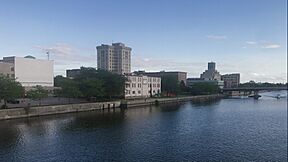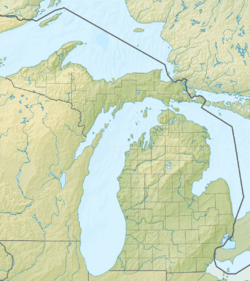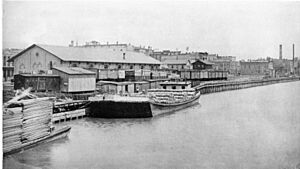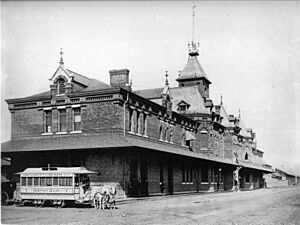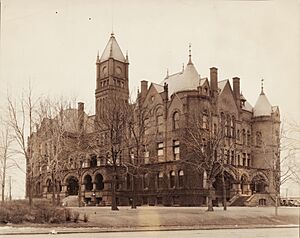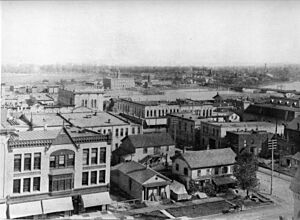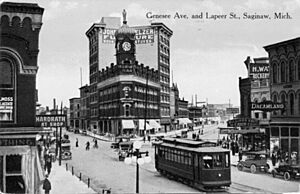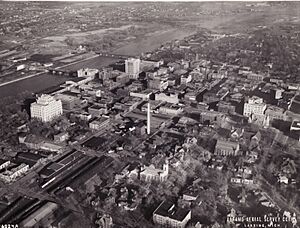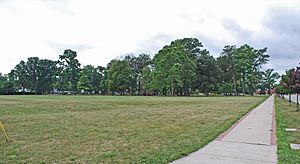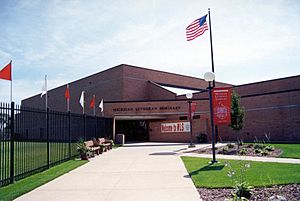Saginaw, Michigan facts for kids
Quick facts for kids
Saginaw, Michigan
|
|||||
|---|---|---|---|---|---|
|
|
|||||
|
|||||
| Nickname(s):
"Sagnasty"
|
|||||
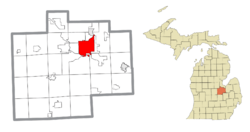
Location within Saginaw County
|
|||||
| Country | |||||
| State | |||||
| County | Saginaw | ||||
| Settled | 1819 | ||||
| Incorporated | 1857 | ||||
| Government | |||||
| • Type | Council–manager | ||||
| Area | |||||
| • City | 17.81 sq mi (46.12 km2) | ||||
| • Land | 17.10 sq mi (44.28 km2) | ||||
| • Water | 0.71 sq mi (1.84 km2) | ||||
| Elevation | 591 ft (180 m) | ||||
| Population
(2020)
|
|||||
| • City | 44,202 | ||||
| • Estimate
(2023)
|
43,185 | ||||
| • Density | 2,585.52/sq mi (998.29/km2) | ||||
| • Urban | 116,058 | ||||
| • Metro | 187,782 | ||||
| • CSA | 374,321 | ||||
| Time zone | UTC−5 (EST) | ||||
| • Summer (DST) | UTC−4 (EDT) | ||||
| ZIP code(s) |
48601–48609, 48638, 48663
|
||||
| Area code(s) | 989 | ||||
| FIPS code | 26-70520 | ||||
| GNIS feature ID | 1627020 | ||||
Saginaw (/ˈsæɡɪnɔː/) is a city in Michigan, United States. It's the main city in Saginaw County. In 2020, about 44,202 people lived there. Saginaw is located along the Saginaw River. It's part of a larger area called the Greater Tri-Cities region in Central Michigan.
Saginaw started as a fort in 1819. It became a busy city for lumber in the 1800s. Later, in the 1900s, it was an important place for making cars and car parts, especially with General Motors. Over time, like many industrial cities, it faced challenges as manufacturing changed. Today, Saginaw is focusing on new industries like clean energy and modern manufacturing.
Contents
What's in a Name?
The name Saginaw probably comes from the Ojibwe language. Many people thought it meant "where the Sauk were." This idea came from a mistake made by explorer Samuel de Champlain on his maps.
However, it's more likely that Saginaw means "place of the outlet." This comes from the Ojibwe words sag (meaning opening) and ong (meaning place of).
Saginaw's Story
Early Days
Long ago, the Anishnabeg people lived where Saginaw is now. French traders and missionaries came to the area in the late 1600s. They met the Ojibwe (Chippewa) people living there.
The first permanent settlement by non-Native Americans was in 1816. Louis Campau set up a trading post on the west side of the Saginaw River. Soon after, the United States built Fort Saginaw.
The Fort and Growth
In 1819, Lewis Cass made a deal with the Ojibwe leaders in the Treaty of Saginaw. This allowed the United States to own and settle the land. In 1822, the United States Army built Fort Saginaw on the west bank of the river.
The fort was left by 1824 because of harsh weather and sickness. For a while, the town didn't grow much. But by the late 1820s, the American Fur Company had a trading post there.
Lumber Boom!
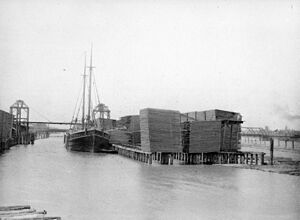
Saginaw grew quickly because of the huge demand for lumber. Michigan had many white pine trees. The Saginaw River and its smaller rivers made it easy to move logs. Logs were floated down to sawmills in Saginaw. From there, the lumber was loaded onto ships and trains.
At first, there were two main settlements: Saginaw on the west side of the river and East Saginaw on the east side. East Saginaw also included a village called Salina, known for making salt. Both Saginaw and East Saginaw became important centers for railroads and ships.
Lumber production was at its highest in the early 1870s. But by the end of the 1800s, most of the trees were cut down. Other industries, like farming and manufacturing, then started to grow.
Becoming One City
On June 28, 1889, the Michigan state government decided to combine the cities of Saginaw and East Saginaw into one big city. This happened officially on March 12, 1890. Even after joining, people from the "east side" and "west side" of Saginaw sometimes had friendly rivalries.
The 1900s: Cars and War
Industrial Growth
In the early 1900s, car making became very popular in Michigan. Saginaw became a key supplier for car factories, especially for General Motors. Companies in Saginaw made steering parts, transmissions, and other car components. This connection to the auto industry shaped Saginaw's future.
During World War II, Saginaw's factories switched to making military supplies. They produced machine guns, armor-piercing shells, and over half a million M1 carbine rifles for the U.S. military. Saginaw played a big part in helping the Allies win the war.
Many people moved to Saginaw during and after the war, especially from the southern United States. This caused the city to grow a lot. New water pipes were built, and an airport (now MBS International Airport) was developed with nearby cities.
City Government Changes

Over the years, Saginaw changed how its city government worked to make it more efficient. In 1935, the city adopted a new system. Now, a city manager runs the daily operations, and a city council of nine members makes the big decisions. This system helped reduce rivalries between the east and west sides of the city.
After World War II
After the war, laws made it harder for cities to grow by adding land from nearby areas. This meant Saginaw's population stopped growing as much. New homes and businesses often chose to build in the surrounding townships instead of within the city limits.
The 2000s: Challenges and New Beginnings
Population Changes
As manufacturing jobs decreased in the late 1900s and early 2000s, Saginaw's population went down. Many people moved away to find work. This led to some empty buildings and other challenges for the community.
Making the City Better
City leaders and community groups have been working hard to improve Saginaw. They are tearing down old, empty buildings to make neighborhoods safer and more attractive.
There are also efforts to bring new life to downtown Saginaw. Old buildings are being fixed up to create new apartments and shops. The city is focusing on new ideas, clean energy, and continuing to make things for export. Saginaw still has more manufacturing jobs than the average U.S. city.
Saginaw's Location
Saginaw covers about 18.10 square miles (46.88 km2) of land and water. It's located on the Saginaw River, about 15 miles (24 km) from Saginaw Bay, which is part of Lake Huron. The city is in the middle of the Saginaw Bay watershed, which is the largest in Michigan. This area also has the biggest freshwater coastal wetland in the United States.
Neighborhoods
Saginaw has many different neighborhoods, including:
- Downtown
- Old Town
- Southwest Village
- Northmoor
- Heritage Square
- Cathedral District
- Houghton Jones Neighborhood
- South East Side
- Triangle Parks
- St. Stephen's Area
- Brockway-Carmen Park
- Butman-Fish Neighborhood
- Redeemer Area
- Saginaw High Neighborhood
- Northeast Side
- Covenant Neighborhood
- Northwest Neighborhood
- Sheridan Park
- The Woods
- Adams Boulevard Area
Weather
Saginaw has a humid continental climate. This means it has warm summers and cold, snowy winters.
| Climate data for Saginaw, Michigan (MBS International Airport), 1991–2020 normals, extremes 1898–present | |||||||||||||
|---|---|---|---|---|---|---|---|---|---|---|---|---|---|
| Month | Jan | Feb | Mar | Apr | May | Jun | Jul | Aug | Sep | Oct | Nov | Dec | Year |
| Record high °F (°C) | 62 (17) |
74 (23) |
87 (31) |
88 (31) |
95 (35) |
104 (40) |
111 (44) |
103 (39) |
100 (38) |
91 (33) |
80 (27) |
67 (19) |
111 (44) |
| Mean maximum °F (°C) | 49.0 (9.4) |
49.5 (9.7) |
65.9 (18.8) |
78.4 (25.8) |
86.6 (30.3) |
92.7 (33.7) |
92.6 (33.7) |
90.5 (32.5) |
88.1 (31.2) |
79.7 (26.5) |
64.7 (18.2) |
52.8 (11.6) |
95.0 (35.0) |
| Mean daily maximum °F (°C) | 29.5 (−1.4) |
31.8 (−0.1) |
42.3 (5.7) |
55.8 (13.2) |
68.6 (20.3) |
78.5 (25.8) |
82.2 (27.9) |
80.0 (26.7) |
73.3 (22.9) |
60.2 (15.7) |
46.2 (7.9) |
34.7 (1.5) |
56.9 (13.8) |
| Daily mean °F (°C) | 23.0 (−5.0) |
24.5 (−4.2) |
34.0 (1.1) |
45.9 (7.7) |
58.2 (14.6) |
68.1 (20.1) |
71.7 (22.1) |
69.7 (20.9) |
62.5 (16.9) |
50.8 (10.4) |
39.0 (3.9) |
28.9 (−1.7) |
48.0 (8.9) |
| Mean daily minimum °F (°C) | 16.4 (−8.7) |
17.3 (−8.2) |
25.7 (−3.5) |
36.1 (2.3) |
47.7 (8.7) |
57.7 (14.3) |
61.2 (16.2) |
59.4 (15.2) |
51.6 (10.9) |
41.4 (5.2) |
31.8 (−0.1) |
23.1 (−4.9) |
39.1 (3.9) |
| Mean minimum °F (°C) | −2.5 (−19.2) |
−1.4 (−18.6) |
7.0 (−13.9) |
23.1 (−4.9) |
34.0 (1.1) |
43.6 (6.4) |
49.9 (9.9) |
48.1 (8.9) |
37.5 (3.1) |
28.2 (−2.1) |
16.9 (−8.4) |
6.4 (−14.2) |
−6 (−21) |
| Record low °F (°C) | −22 (−30) |
−23 (−31) |
−12 (−24) |
8 (−13) |
24 (−4) |
33 (1) |
39 (4) |
37 (3) |
27 (−3) |
19 (−7) |
−3 (−19) |
−12 (−24) |
−23 (−31) |
| Average precipitation inches (mm) | 1.92 (49) |
1.77 (45) |
2.02 (51) |
3.19 (81) |
3.41 (87) |
3.28 (83) |
2.83 (72) |
3.85 (98) |
2.81 (71) |
2.91 (74) |
2.28 (58) |
1.85 (47) |
32.12 (816) |
| Average snowfall inches (cm) | 13.9 (35) |
11.4 (29) |
6.0 (15) |
2.4 (6.1) |
0.0 (0.0) |
0.0 (0.0) |
0.0 (0.0) |
0.0 (0.0) |
0.0 (0.0) |
0.2 (0.51) |
3.3 (8.4) |
11.8 (30) |
49.0 (124) |
| Average extreme snow depth inches (cm) | 8.5 (22) |
7.9 (20) |
6.0 (15) |
1.2 (3.0) |
0.0 (0.0) |
0.0 (0.0) |
0.0 (0.0) |
0.0 (0.0) |
0.0 (0.0) |
0.1 (0.25) |
1.8 (4.6) |
5.0 (13) |
11.7 (30) |
| Average precipitation days (≥ 0.01 in) | 12.6 | 10.1 | 10.1 | 11.8 | 12.0 | 10.2 | 9.9 | 10.5 | 9.7 | 12.0 | 11.5 | 12.2 | 132.6 |
| Average snowy days (≥ 0.1 in) | 10.9 | 8.4 | 5.0 | 1.9 | 0.1 | 0.0 | 0.0 | 0.0 | 0.0 | 0.2 | 2.9 | 8.8 | 38.2 |
| Source: NOAA | |||||||||||||
People of Saginaw
| Historical population | |||
|---|---|---|---|
| Census | Pop. | %± | |
| 1860 | 1,699 | — | |
| 1870 | 7,460 | 339.1% | |
| 1880 | 10,525 | 41.1% | |
| 1890 | 46,322 | 340.1% | |
| 1900 | 42,345 | −8.6% | |
| 1910 | 50,510 | 19.3% | |
| 1920 | 61,903 | 22.6% | |
| 1930 | 80,715 | 30.4% | |
| 1940 | 82,794 | 2.6% | |
| 1950 | 92,918 | 12.2% | |
| 1960 | 98,265 | 5.8% | |
| 1970 | 91,849 | −6.5% | |
| 1980 | 77,508 | −15.6% | |
| 1990 | 69,512 | −10.3% | |
| 2000 | 61,799 | −11.1% | |
| 2010 | 51,508 | −16.7% | |
| 2020 | 44,202 | −14.2% | |
| 2023 (est.) | 43,185 | −16.2% | |
| U.S. Decennial Census 2010 2020 |
|||
Saginaw is the largest city in the Saginaw-Midland-Bay City, MI CSA. This larger area includes Saginaw, Midland, and Bay City, and had about 377,474 people in 2020.
What the 2020 Census Shows
| Race / Ethnicity | Pop 2000 | Pop 2010 | Pop 2020 | % 2000 | % 2010 | % 2020 |
|---|---|---|---|---|---|---|
| White alone (NH) | 26,372 | 19,310 | 15,227 | 42.67% | 37.49% | 34.45% |
| Black or African American alone (NH) | 26,440 | 23,127 | 19,176 | 42.78% | 44.90% | 43.38% |
| Native American or Alaska Native alone (NH) | 224 | 180 | 120 | 0.36% | 0.35% | 0.27% |
| Asian alone (NH) | 197 | 145 | 184 | 0.32% | 0.28% | 0.42% |
| Pacific Islander alone (NH) | 6 | 10 | 17 | 0.01% | 0.02% | 0.04% |
| Some Other Race alone (NH) | 116 | 72 | 271 | 0.19% | 0.14% | 0.61% |
| Mixed Race/Multi-Racial (NH) | 1,185 | 1,320 | 2,219 | 1.92% | 2.56% | 5.02% |
| Hispanic or Latino (any race) | 7,259 | 7,344 | 6,988 | 11.75% | 14.26% | 15.81% |
| Total | 61,799 | 51,508 | 44,202 | 100.00% | 100.00% | 100.00% |
In 2010, Saginaw had 51,508 people living in 19,799 households. About 36% of households had children under 18. The average age in the city was 33.5 years old.
Saginaw's Economy
For much of the 1900s, Saginaw's economy was mostly about making things for cars. This included parts like transmissions and steering gears. At its busiest in the 1960s and 1970s, Saginaw and nearby areas had many General Motors factories and other companies making auto parts.
Today, the main shopping area for Saginaw is in nearby Saginaw Township. This area has many large stores and restaurants. Within the city, Old Town and downtown Saginaw also offer places to shop and eat.
Fun and Culture
Downtown Saginaw is a center for entertainment. Places like The Dow Event Center and the Temple Theatre host live shows. The Saginaw Bay Symphony Orchestra and Saginaw Choral Society perform here.
The Saginaw Historical Society is located downtown in a building that looks like a castle. The Saginaw Art Museum has many artworks and has recently been updated.
The Celebration Square area has a real Japanese Tea House, which is the only one of its kind in Michigan! The Andersen Enrichment Center and Rose Gardens are also here, hosting art shows and summer concerts.

Downtown Saginaw has seen a comeback with new local restaurants and coffee shops. Old Town, on the other side of the river, also has popular spots. Saginaw is home to Pit and Balcony, one of the oldest community theaters in the United States, started in 1932.
Parks and Museums
The Castle Museum of Saginaw County History is a famous museum downtown. It's in a building that looks like a castle, showing off the area's French history. It has over 100,000 items in its collection.
The Andersen Enrichment Center and Lucille E. Andersen Memorial Rose Garden are beautiful places to visit. They host events like art fairs and jazz concerts. The garden has a fountain with a sculpture by Marshall Fredericks.
The Saginaw Art Museum has both temporary and permanent art collections. It's also connected to the Smithsonian Institution.
Saginaw has a Japanese Cultural Center, Tea House, and Garden. This is because Saginaw is a "Sister City" with Tokushima, Japan. The Tea House is very authentic and hosts traditional tea ceremonies. Every September, a Japan Festival is held with Japanese singers, dancers, and cultural demonstrations.
The city is also home to the Theodore Roethke Home Museum, which honors a famous American poet who grew up in Saginaw. Ojibway Island in the Saginaw River has Rust Park and an outdoor theater.
Sports Fun
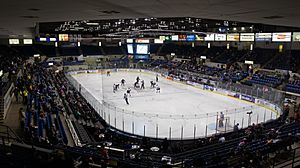
Saginaw has a junior ice hockey team called the Saginaw Spirit, which plays in the Ontario Hockey League. The Spirit even hosted and won the 2024 Memorial Cup. The Saginaw Sting was an indoor football team that started in 2007.
At the college level, Saginaw Valley State University has many sports teams, including American Football, Basketball, and Volleyball.
| Team | Sport | League | Year founded | Venue |
|---|---|---|---|---|
| Saginaw Spirit | Ice hockey | Ontario Hockey League | 2002 | Dow Event Center |
| Saginaw Valley State University | Various | Great Lakes Intercollegiate Athletic Conference | 1963 | SVSU Campus |
Learning in Saginaw
Schools for Kids and Teens
The Saginaw Public School District (SPSD) serves the city. It has elementary schools, middle schools, and high schools. The two public high schools are Saginaw United High School and the Saginaw Arts and Sciences Academy. Michigan Lutheran Seminary is a private high school in the city. There are also several charter schools.
Colleges and Universities
Saginaw is close to Delta College and Saginaw Valley State University, both located in University Center. Central Michigan University also has a center in Saginaw that offers college degrees. Delta College opened a new downtown facility in 2019.
Media in Saginaw
TV Stations
Saginaw is part of a TV market that includes Flint, Bay City, and Midland. WNEM-TV (CBS) has its studios in Saginaw. WJRT (ABC) also has offices and newsrooms in Saginaw.
| Television stations in the Saginaw, Michigan area (Ascending order) | |||||
|---|---|---|---|---|---|
| Channel | Call letters | Description | Comments | ||
| 5 | WNEM-TV | CBS affiliate | Licensed to Bay City; studios in Saginaw | ||
| 12 | WJRT-TV | ABC affiliate | Based and licensed in Flint | ||
| 19 | WDCQ-TV | PBS member station | Licensed to Bad Axe; studios at Delta College in University Center | ||
| 24 | W24DL-D | 3ABN affiliate | Based and licensed in Saginaw; programmed via satellite | ||
| 25 | WEYI-TV | NBC affiliate | Licensed to Saginaw; studios in Clio | ||
| 46 | WBSF | CW affiliate | Licensed to Bay City; studios in Clio | ||
| 49 | WAQP | TCT O&O affiliate | Based and licensed in Saginaw | ||
| 66 | WSMH | Fox affiliate | Based and licensed in Flint | ||
Radio Stations
Saginaw and Saginaw Township have many radio stations. These include local family-owned stations and larger company-owned stations.
| AM radio stations | |||||
|---|---|---|---|---|---|
| Frequency | Call sign | Name | Format | Owner | City |
| 790 AM | WSGW | Newsradio 790 | News/Talk | Alpha Media | Saginaw |
| 1250 AM | WJMK | MeTV FM | Oldies | Northern States Broadcasting Corporation | Bridgeport |
| 1400 AM | WSAM | The Bay 1400 AM and 104FM | Adult Contemporary | MacDonald Broadcasting | Saginaw |
| FM radio stations | |||||
|---|---|---|---|---|---|
| Frequency | Call sign | Name | Format | Owner | City |
| 90.9 FM | WTRK | Air 1 | Contemporary Christian | Educational Media Foundation | Freeland |
| 93.3 FM | WKQZ | The Rock Station, Z93 | Modern rock | Cumulus Media | Midland; studios in Saginaw |
| 93.7 FM | WRCL | Club 93.7 | Rhythmic contemporary | Townsquare Media | Frankenmuth; studios in Burton |
| 94.5 FM | WCEN-FM | 94.5 The Moose | Country music | Alpha Media | Hemlock; studios in Saginaw |
| 96.1 FM | WHNN | My 96.1 | Adult Contemporary | Cumulus Media | Bay City; studios in Saginaw |
| 98.1 FM | WKCQ | 98.1 KCQ | Country music | MacDonald Broadcasting | Saginaw |
| 100.5 FM | WSGW-FM | FM Talk 100.5 | News/Talk | Alpha Media | Carrollton; studios in Saginaw |
| 102.5 FM | WIOG | The Hit Music Channel | Contemporary hits | Cumulus Media | Bay City; studios in Saginaw |
| 104.5 FM | WILZ | Wheelz 104.5 | Classic rock | Cumulus Media | Saginaw |
| 106.3 FM | WGER | 106.3 The Core | Modern rock | Alpha Media | Saginaw |
| 107.1 FM | WTLZ | KISS 107.1 | Urban adult contemporary | Alpha Media | Saginaw |
Newspapers
- The Saginaw News—published Tuesday, Thursday, Friday, Sunday
- Review Magazine—published every two weeks
- The Saginaw Press—published weekly
- The Township Times—published weekly
- The Township View—published weekly
City Services
Getting Around
Saginaw was once a big railroad center. Trains went to many cities like Bay City, Port Huron, and Chicago. Most passenger trains stopped running in the 1950s and 1960s. Today, freight trains still operate in Saginaw. The Saginaw Railway Museum works to save the history of railroading in the area.
Saginaw is served by two main airports: MBS International Airport in Freeland and Bishop International Airport in Flint. There are also smaller airports nearby.
Major highways like I-75 and I-675 connect Saginaw to other parts of Michigan and beyond. The Saginaw River runs through the city, connecting it to Saginaw Bay and the Great Lakes.
Buses provide public transportation in Saginaw and nearby areas through the Saginaw Transit Authority Regional Services (STARS) system. You can also take intercity buses from Saginaw.
Main Roads
 I-75 runs along the east side of the city.
I-75 runs along the east side of the city. I-675 is a short highway loop that goes through downtown Saginaw.
I-675 is a short highway loop that goes through downtown Saginaw. M-13 goes through downtown Saginaw and north to Standish.
M-13 goes through downtown Saginaw and north to Standish. M-46 crosses Michigan from east to west, going through Saginaw.
M-46 crosses Michigan from east to west, going through Saginaw. M-47 passes through the western suburbs and connects to MBS International Airport.
M-47 passes through the western suburbs and connects to MBS International Airport. M-52 runs from the Ohio border to M-46 in Saginaw's western suburbs.
M-52 runs from the Ohio border to M-46 in Saginaw's western suburbs. M-58 runs from M-47 to I-675.
M-58 runs from M-47 to I-675. M-81 runs east from M-13.
M-81 runs east from M-13. M-84 runs from downtown Bay City to M-58 in Saginaw.
M-84 runs from downtown Bay City to M-58 in Saginaw.
Water and Power
Saginaw gets its electricity and natural gas from Consumers Energy.
The city opened its main water treatment plant in 1929. Today, Saginaw and Midland jointly own a water supply company. They get their water from Lake Huron through a 65-mile-long (105 km) pipeline built in 1948.
Staying Healthy
Saginaw has several hospitals and medical centers.
- Aleda E. Lutz Veterans Affairs Medical Center serves America's Veterans.
- Covenant Medical Center is a large hospital with many beds and an emergency department. It's the main trauma center for the region.
- Mary Free Bed at Covenant HealthCare offers special rehabilitation services.
- Ascension Saint Mary's of Michigan is another hospital that treats many different health issues.
Famous People from Saginaw
Sister Cities
Saginaw has "sister city" relationships with cities around the world to promote cultural exchange:
- Amanokrom, Akuapim North District, Ghana
- Awka, Anambra, Nigeria
- Cambridge, Ontario, Canada
- Tokushima, Tokushima Prefecture, Japan
- Zapopan, Jalisco, Mexico
See also
 In Spanish: Saginaw para niños
In Spanish: Saginaw para niños


